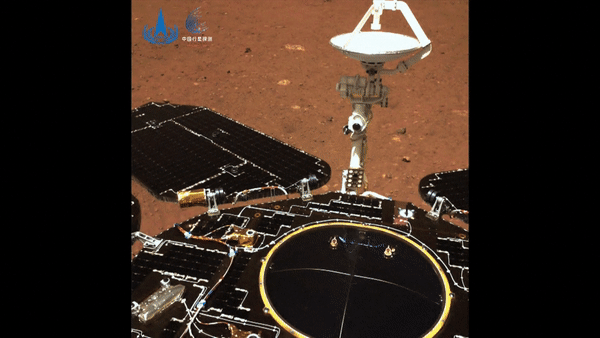China's Mars rover may never wake up because of Martian dust
The mission's chief designer says the rover has most likely been hampered by dust.

The chief designer of China's Mars exploration program has provided a long-awaited comment on the status of the country's Zhurong Mars rover.
The solar-powered Zhurong rover, which is part of China's Tianwen 1 Mars mission, had been hibernating during winter in the planet's northern hemisphere since May 2022. It was expected to wake up autonomously in December, once lighting conditions and temperature had improved.
However, China remained silent regarding Zhurong as December came and went. NASA's Mars Reconnaissance Orbiter confirmed in February that the rover has remained stationary for months.
Related: Chinese scientists hold out hope for silent Zhurong Mars rover

Now, mission chief designer Zhang Rongqiao told China Central Television this week that the team believes Zhurong has not woken up because a higher-than-expected amount of dust has accumulated on the rover's solar panels. This means sunlight received by Zhurong has not been sufficient for it to wake up.
"We estimate that the biggest possibility is that the unpredictable accumulation of dust on Mars has led to a decrease in power generation capacity, which is not high enough to wake it up," Zhang said.
The threshold for Zhurong to resume activities is a temperature of greater than 5 degrees Fahrenheit (minus 15 degrees Celsius) and energy generation of greater than 140 watts.
Get the Space.com Newsletter
Breaking space news, the latest updates on rocket launches, skywatching events and more!
Zhang said that if dust levels on the panels were 30% greater than expected, then Zhurong would require the strongest sunlight levels on Mars to reactivate. A level of 40% or more above expected levels would mean the rover will not be able to wake up.
Summer solstice in the northern hemisphere on Mars occurs in mid-July, according to the Planetary Society, when lighting and temperature conditions may be the most favorable.
Both of NASA's long-lived Spirit and Opportunity rovers finally succumbed to Martian dust covering their solar panels, reducing power generation to below adequate levels for operation.
Zhurong landed in Utopia Planitia in May 2021, marking success at the first attempt at a Mars landing for China. The rover entered a dormant mode in May 2022.
Whether or not Zhurong comes back to life, the mission already exceeded its planned lifetime of three Earth months. The rover has also, like its companion Tianwen 1 orbiter, completed its primary science goals.
Follow us @Spacedotcom, or on Facebook and Instagram.
Join our Space Forums to keep talking space on the latest missions, night sky and more! And if you have a news tip, correction or comment, let us know at: community@space.com.

Andrew is a freelance space journalist with a focus on reporting on China's rapidly growing space sector. He began writing for Space.com in 2019 and writes for SpaceNews, IEEE Spectrum, National Geographic, Sky & Telescope, New Scientist and others. Andrew first caught the space bug when, as a youngster, he saw Voyager images of other worlds in our solar system for the first time. Away from space, Andrew enjoys trail running in the forests of Finland. You can follow him on Twitter @AJ_FI.
-
Cloudrunner7 A quick question for those engineers and scientists involved with Martian Rovers: why can't some system be placed on the Rovers to periodically remove the dust that accumulates? I know that weight is a huge consideration, but I am guessing that a decent system could be built for less than 3-5 kilograms. If it added years to the operating life of a Rover, I think that it would be worth the extra weight.Reply
One simple example might be a system that would contain a bottle to store compressed Martian air, an intake mechanism and a few fixed nozzles pointing over the surfaces of the solar cells through which compressed air would be periodically blown to remove the dust. The intake function could be run periodically when there was spare battery power from the Rover batteries and would be short duration so as not to be too much of a drain on the batteries. The dusting off function would be explosive releases of some of the stored air to blast the dust off and would require very little power. The storage bottle would obviously have to be pretty strong so as to have zero chance of exploding from the compressed air, and the various values would have to be of extremely high quality so as not to freeze up or be chocked by dust. The system would have to be designed to store a full charge of compressed air over the winter if the Rover hibernated and to automatically do a dust blow-off when spring was far enough advanced. Why couldn't this system work? Many variations could be thought up by interested people.
Thanks to all who respond, I am looking forward to learning a lot.









